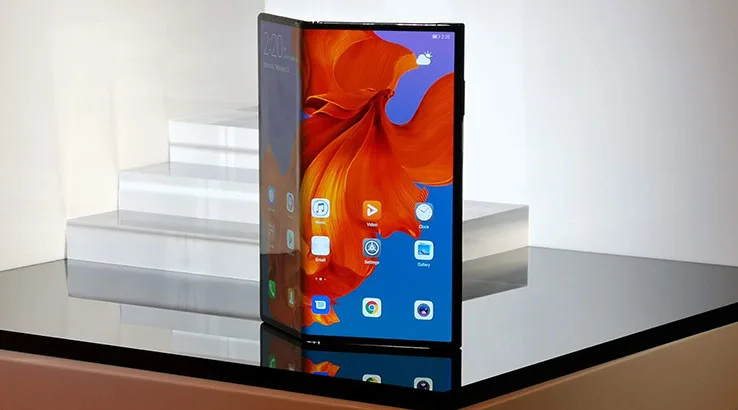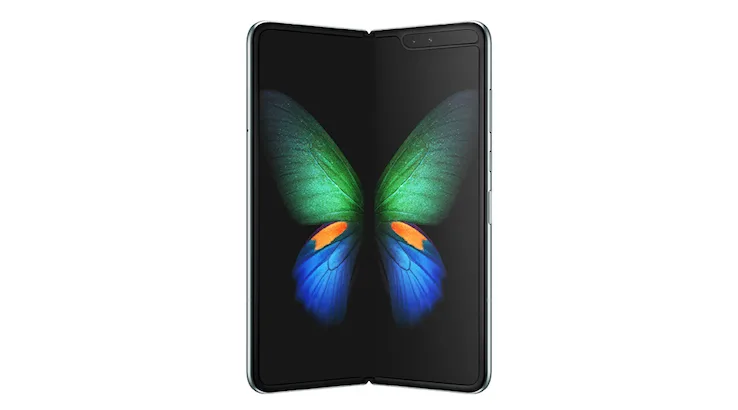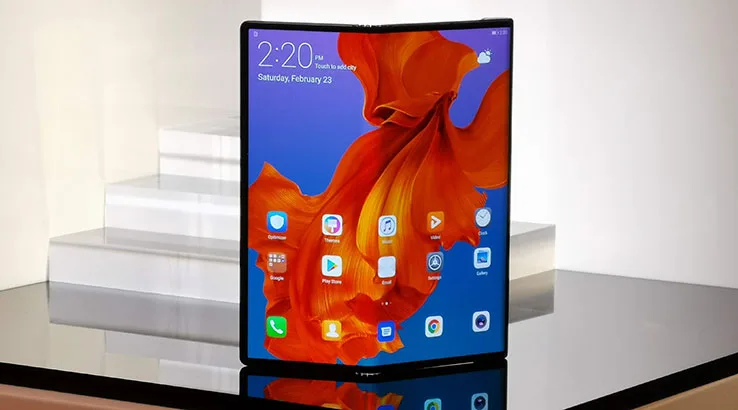
How do the Huawei Mate X and Samsung Galaxy Fold's take on what a foldable phone should be compare?
Samsung Galaxy Fold vs Huawei Mate X: Specs
|
|
|
|
|---|---|---|
| Product Name | Huawei Mate X | Samsung Galaxy Fold |
| Display size | 8 | 7.3 |
| Operating system | Android 9 | Android 9 |
| Height (mm) | 161.3 | 160.9 |
| Width (mm) | 146.2 | 117.9 |
| Depth (mm) | 5.4 | 6.9 |
| Weight (g) | 295 | 276 |
| Battery size (mAh) | 4,500 | 4,380 |
| Front camera (1) megapixels | 10 | |
| Rear camera (1) megapixels | 40 | 12 |
| Rear camera (2) megapixels | 16 | 12 |
| Water Resistance | N/A | N/A |
| Wi-Fi connectivity | 802.11 a/b/g/n/ac | 802.11 a/b/g/n/ac |
| Network Category Speed | N/A | N/A |
We've known for some time that the most heavily hyped trend in smartphone design for 2019 wasn't going to be a new type of notch, or a connector to replace USB C, or even a battery that never needs recharging. Although that last one would be exceptionally sweet if any smartphone designers happen to be listening.
No, it'll be in foldable phones that we'll see the most hype, and we've already had two heavily hyped handsets launch in the past couple of days.
Samsung was first to "launch", with the Samsung Galaxy Fold opening its Samsung Galaxy Unpacked event on Thursday. Huawei followed up with the launch of the Huawei Mate X on Sunday in Barcelona.
Now, I've got to use the word "launch" here advisedly, as there's not an entire picture of availability for the new foldable phones just yet. We don't quite have the full picture of their specifications, and it's feasible that they may change before going to actual retail.
Still, based on what we do know, it's clear that Samsung and Huawei have produced quite different takes on what a consumer might want out of a foldable phone.

Samsung Galaxy Fold vs Huawei Mate X: Display
The Samsung Galaxy Fold is a 7.3 inch tablet when it's unfolded, and a 4.6 inch phone in its folded state. Whichever side you're looking at, it's a Dynamic AMOLED display, with the main unfolded display giving you QXGA+ resolution, while the smaller 4.6 inch display offers HD+ resolution.
The Huawei Mate X is quite a bit larger. As a phone, it's a 6.6 inch device with an exterior AMOLED display, but when you unfold it, it becomes a full 8 inch tablet.
It's not hard to see that in straight line measurement terms, the Huawei Mate X is bigger, but that's not always going to be better. It's very much a matter of relating it to your needs. If the appeal of having a foldable phone is that you can have a good tablet in your lap that folds easily into your pocket, having a device that becomes a smaller phone might be just what you need.

Samsung Galaxy Fold vs Huawei Mate X: Power
Samsung's announced specifications for the Galaxy Fold as unveiled at its Galaxy Unpacked 2019 event talk of a 7nm 64-bit Octa-core processor. It's not assured but fairly likely that this is the Qualcomm Snapdragon 855, paired with an impressive 12GB of RAM.
That's a potent combination, but it's going up against one of the best Android CPUs we hit in 2018, in the form of Huawei's own Kirin 980 processor.
We've already tested that in the Huawei Mate 20 Pro, and it's expected to also form the heart of the Huawei P30 Pro. Its use in the Huawei Mate X means it should have good performance – but it might just get beaten out by the Snapdragon 855, especially on a foldable phone with that much RAM.
On the storage front, it's a very mixed story. The Samsung Galaxy Fold has a fixed storage capacity, with no support for expandable memory cards. The Huawei Mate X does support expandable storage, but it's in Huawei's proprietary "nm" format, which is rather more expensive than standard microSD cards.

Samsung Galaxy Fold vs Huawei Mate X: Camera
When you make a foldable phone, you do interesting things to the way the cameras work. On a regular phone, you can move the cameras around by flipping the phone around, but for a foldable phone, that flipping happens within the actual phone body.
Samsung's gone all out for the Galaxy Fold, with an impressive six cameras in total across the camera body. There's a 10MP selfie camera for the Cover Display, dual 10MP selfie camera and 8MP RGB depth camera on the main display front and a rear triple camera with a 16MP ultra wide 123-degree angle lens, a 12MP wide-angle camera with dual pixel autofocus, optic image stablisation (OIS) and f1.4/f2.4 aperture. It's more or less the Galaxy S10+ camera system plus one.
The Huawei Mate X features, at least on the model we've seen demonstrated, just three cameras, with no front-facing camera built into the actual display. The way it folds means you can use all three cameras for selfie purposes, or portrait shooting while still having your subject actually see the camera when folded up, which is a neat application for a folding phone.

Samsung Galaxy Fold vs Huawei Mate X: Networking
As the name suggests, the Huawei Mate X will be a 5G-capable phone, using Huawei's own Balong 5000 5G modem. Huawei's currently not allowed to provide networking components for Australia's 5G networks, but there's nothing to stop it selling 5G phones in the country. The Balong 5000 has some pretty impressive specifications, and the Mate X could be technically capable of download speeds up to an impressive 4.6Gbps.
For its part, Samsung stated at its Galaxy Unpacked launch that it would be building the Samsung Galaxy Fold in both 4G and 5G versions.
That's no doubt so it can target different market rollouts and availability of 5G networks, but then again, 5G phones will just naturally step back to 4G anyway. It's fair to presume that Samsung would opt for Qualcomm's X50 5G modem, unless it decides to hold off on 5G Galaxy Folds until late 2019, when it could conceivably opt for the X55 modem instead. That would give it a potential download speed of up to 7Gbps.

Samsung Galaxy Fold vs Huawei Mate X: Battery
The Galaxy Fold features a 4,380mAh dual battery to power both of its displays, while the Huawei Mate X runs off a dual 4,500mAh battery system. That might seem to give the Huawei Mate X a slight edge, but battery life is more than just a numbers game.
The smaller AMOLED display on the Galaxy Fold means it has to draw less power to create its onscreen images relative to the larger display on the Mate X.
The 5G radios on the Mate X may also draw more power than on a comparable 4G LTE Galaxy Fold. Then there's the question of the battery optimisations within either phone's processors. The Kirin 980 at the heart of the Huawei Mate X has some pretty fierce battery optimisation at its core, and we're yet to put it head to head with the Snapdragon 855 that's expected to power the Galaxy Fold.
On the charging side, Huawei claims that it supports up to 55W charging, which means it should take just 30 minutes to charge to 85% capacity.

Samsung Galaxy Fold vs Huawei Mate X: Price
The Galaxy Fold pricing we do have suggests a conversion to around $2,800, but it's not clear if that includes any sales taxes. In Australia GST has to be levied, which raises the prospect that the Galaxy Fold might even tip the scales just over $3,000 outright.
Huawei, for its part, has come to the market with a price point that's even higher. As announced on stage, its list price of EUR€2,299 equates out to around $3,700 – maybe more once taxes come into play or if the Australian dollar dips further before it launches – would make it by far the most expensive smartphone ever put to sale in Australia, and not by a small margin.
It was inevitable that the very early adopters for foldable phones would be expected to bear a premium to pay for all that research and development time, but at those prices it may be some time before we see more truly affordable foldable options emerge.
For more news from MWC 2019, check out our MWC 2019 news hub.
Latest mobile phone news
More guides on Finder Shopping
-
The best budget phones in Australia for 2024
Our expert team has tested hundreds of mobile phones to find the 11 best options under $500.
-
Best dual SIM phones in Australia
If you’re looking to run multiple phone numbers from just one handset, we’ve got the best picks for every price bracket and need.
-
Best flip phones in Australia
These are the 4 best flip phones you can buy right now in Australia.
-
The best mid-range phones for 2024, tested by our expert editors
Looking to save a few dollars without skimping on premium features? We've sorted out the best mid-range phones that money can buy.
-
Compare Xiaomi smartphones to find the best option for you
If you're after premium power and the latest features at an affordable price, you'll want to give Xiaomi's smartphones a look.
-
Best iPhone alternatives in Australia for 2024
Looking for an alternative to your iPhone? We've rounded up the best smartphone alternatives whether your passion is for better photography or more battery life.
-
Samsung Galaxy S10e vs Apple iPhone XR
How does Samsung's more affordable Galaxy S10e compare against Apple's lower-cost Apple iPhone XR?
-
Sydney’s mobile phone market is ripe for competition
Telstra overshadows other networks nationally but Vodafone rules Sydney's populous urban sprawl.
-
What resolution does my phone camera actually need?
Not sure what resolution you need on your phone's camera? This guide explains the features you really need to check on your smartphone.
-
The 10 best phones in Australia 2024
We've ranked the top 10 smartphones you can buy in Australia right now based on hundreds of hours of hands-on testing.

